Intercultural Competence in the Workplace: Analysis of 'Outsourced'
VerifiedAdded on 2023/06/11
|14
|5104
|316
Essay
AI Summary
This essay delves into the crucial topic of developing intercultural competence in the workplace, using the film 'Outsourced' as a case study. It examines the cultural clashes experienced by the main character, Todd Hamilton, as he navigates the challenges of managing a team in India. The essay applies various cross-cultural models, including Hofstede's cultural dimensions, Hall's high-context versus low-context cultures, and Trompenaars' specific versus diffuse orientations, to analyze the differences between American and Indian cultures. By highlighting these cultural disparities, the essay provides insights into the importance of intercultural understanding and offers recommendations for fostering effective communication and collaboration in diverse workplace environments. The analysis demonstrates how developing intercultural competencies can lead to improved personal and professional growth, ultimately benefiting both the individual and the organization.
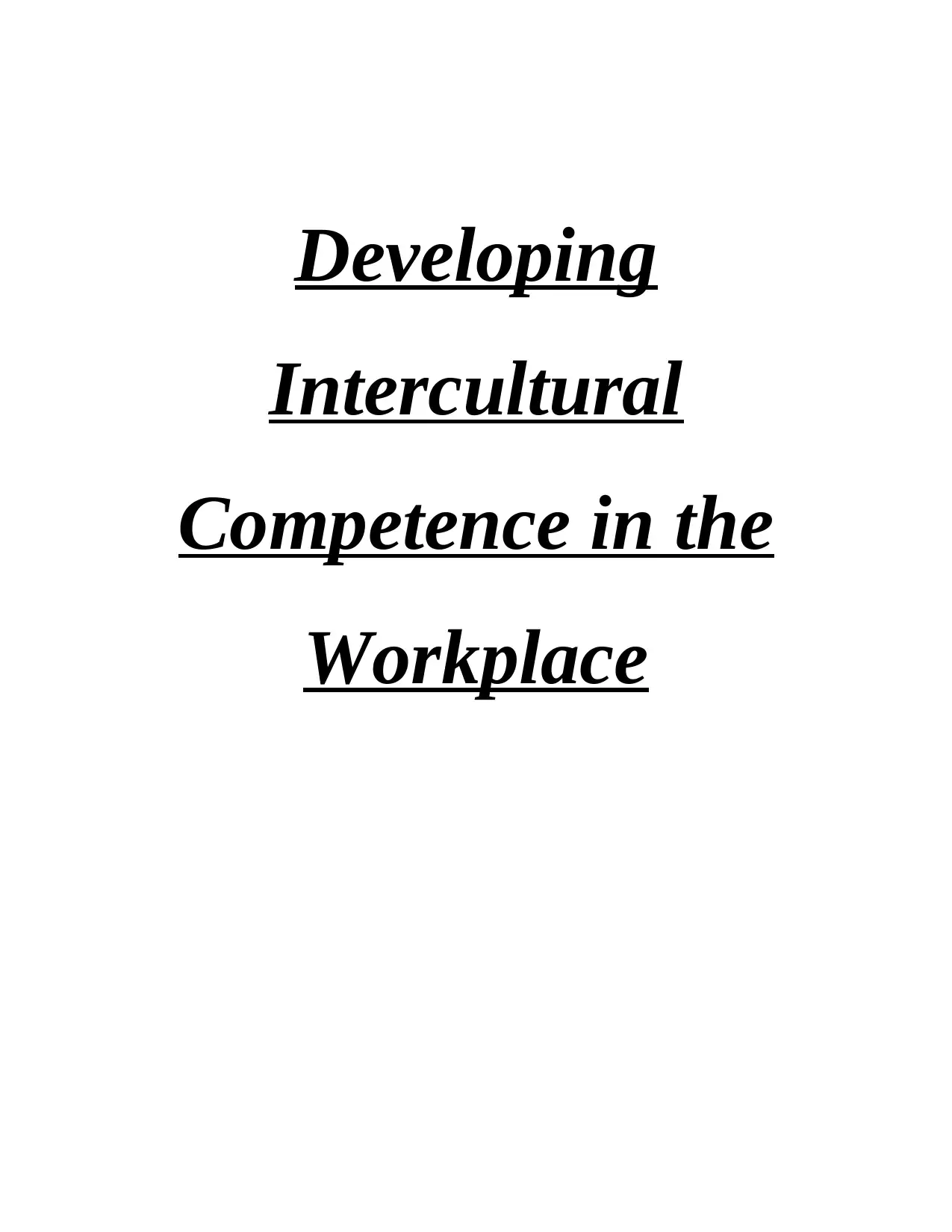
Developing
Intercultural
Competence in the
Workplace
Intercultural
Competence in the
Workplace
Paraphrase This Document
Need a fresh take? Get an instant paraphrase of this document with our AI Paraphraser
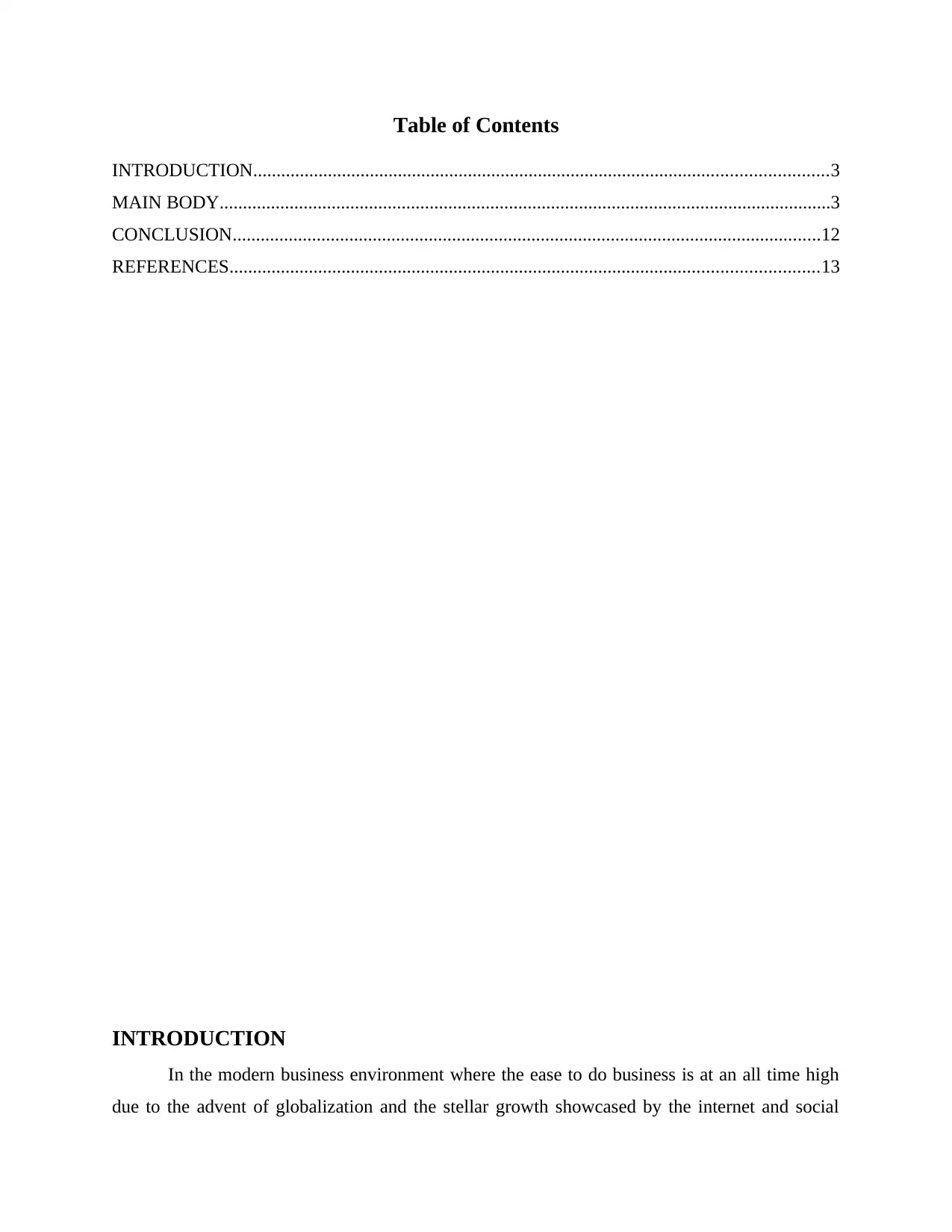
Table of Contents
INTRODUCTION...........................................................................................................................3
MAIN BODY...................................................................................................................................3
CONCLUSION..............................................................................................................................12
REFERENCES..............................................................................................................................13
INTRODUCTION
In the modern business environment where the ease to do business is at an all time high
due to the advent of globalization and the stellar growth showcased by the internet and social
INTRODUCTION...........................................................................................................................3
MAIN BODY...................................................................................................................................3
CONCLUSION..............................................................................................................................12
REFERENCES..............................................................................................................................13
INTRODUCTION
In the modern business environment where the ease to do business is at an all time high
due to the advent of globalization and the stellar growth showcased by the internet and social
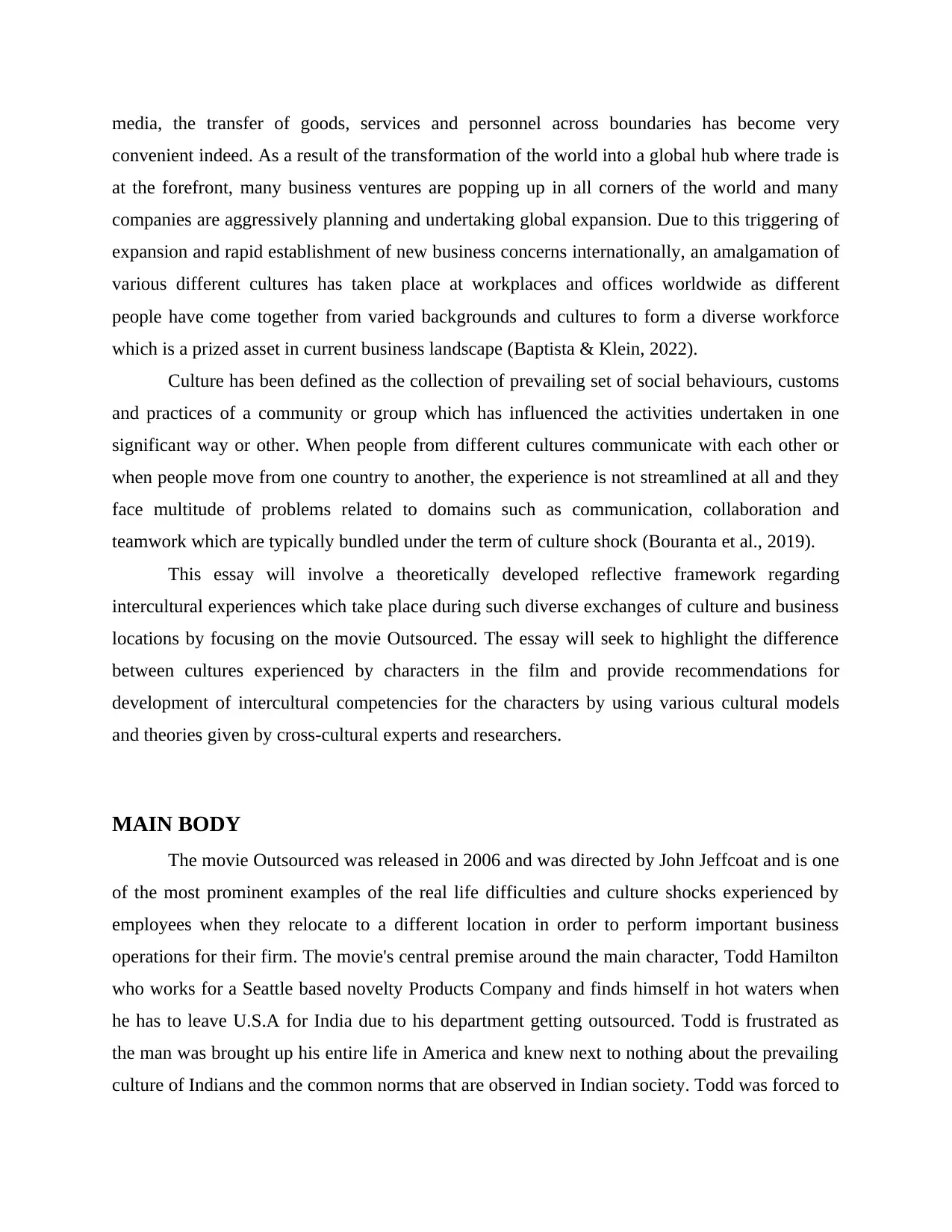
media, the transfer of goods, services and personnel across boundaries has become very
convenient indeed. As a result of the transformation of the world into a global hub where trade is
at the forefront, many business ventures are popping up in all corners of the world and many
companies are aggressively planning and undertaking global expansion. Due to this triggering of
expansion and rapid establishment of new business concerns internationally, an amalgamation of
various different cultures has taken place at workplaces and offices worldwide as different
people have come together from varied backgrounds and cultures to form a diverse workforce
which is a prized asset in current business landscape (Baptista & Klein, 2022).
Culture has been defined as the collection of prevailing set of social behaviours, customs
and practices of a community or group which has influenced the activities undertaken in one
significant way or other. When people from different cultures communicate with each other or
when people move from one country to another, the experience is not streamlined at all and they
face multitude of problems related to domains such as communication, collaboration and
teamwork which are typically bundled under the term of culture shock (Bouranta et al., 2019).
This essay will involve a theoretically developed reflective framework regarding
intercultural experiences which take place during such diverse exchanges of culture and business
locations by focusing on the movie Outsourced. The essay will seek to highlight the difference
between cultures experienced by characters in the film and provide recommendations for
development of intercultural competencies for the characters by using various cultural models
and theories given by cross-cultural experts and researchers.
MAIN BODY
The movie Outsourced was released in 2006 and was directed by John Jeffcoat and is one
of the most prominent examples of the real life difficulties and culture shocks experienced by
employees when they relocate to a different location in order to perform important business
operations for their firm. The movie's central premise around the main character, Todd Hamilton
who works for a Seattle based novelty Products Company and finds himself in hot waters when
he has to leave U.S.A for India due to his department getting outsourced. Todd is frustrated as
the man was brought up his entire life in America and knew next to nothing about the prevailing
culture of Indians and the common norms that are observed in Indian society. Todd was forced to
convenient indeed. As a result of the transformation of the world into a global hub where trade is
at the forefront, many business ventures are popping up in all corners of the world and many
companies are aggressively planning and undertaking global expansion. Due to this triggering of
expansion and rapid establishment of new business concerns internationally, an amalgamation of
various different cultures has taken place at workplaces and offices worldwide as different
people have come together from varied backgrounds and cultures to form a diverse workforce
which is a prized asset in current business landscape (Baptista & Klein, 2022).
Culture has been defined as the collection of prevailing set of social behaviours, customs
and practices of a community or group which has influenced the activities undertaken in one
significant way or other. When people from different cultures communicate with each other or
when people move from one country to another, the experience is not streamlined at all and they
face multitude of problems related to domains such as communication, collaboration and
teamwork which are typically bundled under the term of culture shock (Bouranta et al., 2019).
This essay will involve a theoretically developed reflective framework regarding
intercultural experiences which take place during such diverse exchanges of culture and business
locations by focusing on the movie Outsourced. The essay will seek to highlight the difference
between cultures experienced by characters in the film and provide recommendations for
development of intercultural competencies for the characters by using various cultural models
and theories given by cross-cultural experts and researchers.
MAIN BODY
The movie Outsourced was released in 2006 and was directed by John Jeffcoat and is one
of the most prominent examples of the real life difficulties and culture shocks experienced by
employees when they relocate to a different location in order to perform important business
operations for their firm. The movie's central premise around the main character, Todd Hamilton
who works for a Seattle based novelty Products Company and finds himself in hot waters when
he has to leave U.S.A for India due to his department getting outsourced. Todd is frustrated as
the man was brought up his entire life in America and knew next to nothing about the prevailing
culture of Indians and the common norms that are observed in Indian society. Todd was forced to
⊘ This is a preview!⊘
Do you want full access?
Subscribe today to unlock all pages.

Trusted by 1+ million students worldwide
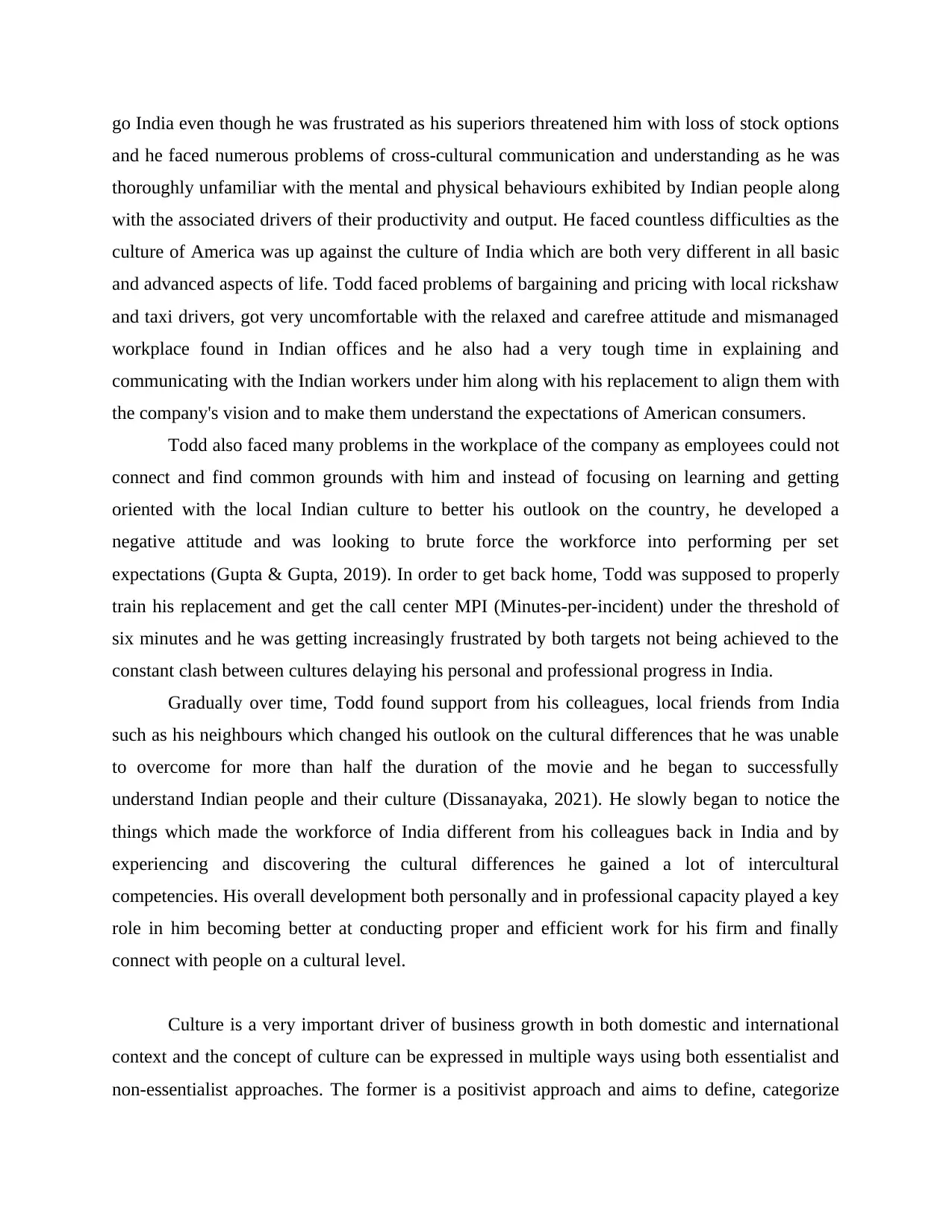
go India even though he was frustrated as his superiors threatened him with loss of stock options
and he faced numerous problems of cross-cultural communication and understanding as he was
thoroughly unfamiliar with the mental and physical behaviours exhibited by Indian people along
with the associated drivers of their productivity and output. He faced countless difficulties as the
culture of America was up against the culture of India which are both very different in all basic
and advanced aspects of life. Todd faced problems of bargaining and pricing with local rickshaw
and taxi drivers, got very uncomfortable with the relaxed and carefree attitude and mismanaged
workplace found in Indian offices and he also had a very tough time in explaining and
communicating with the Indian workers under him along with his replacement to align them with
the company's vision and to make them understand the expectations of American consumers.
Todd also faced many problems in the workplace of the company as employees could not
connect and find common grounds with him and instead of focusing on learning and getting
oriented with the local Indian culture to better his outlook on the country, he developed a
negative attitude and was looking to brute force the workforce into performing per set
expectations (Gupta & Gupta, 2019). In order to get back home, Todd was supposed to properly
train his replacement and get the call center MPI (Minutes-per-incident) under the threshold of
six minutes and he was getting increasingly frustrated by both targets not being achieved to the
constant clash between cultures delaying his personal and professional progress in India.
Gradually over time, Todd found support from his colleagues, local friends from India
such as his neighbours which changed his outlook on the cultural differences that he was unable
to overcome for more than half the duration of the movie and he began to successfully
understand Indian people and their culture (Dissanayaka, 2021). He slowly began to notice the
things which made the workforce of India different from his colleagues back in India and by
experiencing and discovering the cultural differences he gained a lot of intercultural
competencies. His overall development both personally and in professional capacity played a key
role in him becoming better at conducting proper and efficient work for his firm and finally
connect with people on a cultural level.
Culture is a very important driver of business growth in both domestic and international
context and the concept of culture can be expressed in multiple ways using both essentialist and
non-essentialist approaches. The former is a positivist approach and aims to define, categorize
and he faced numerous problems of cross-cultural communication and understanding as he was
thoroughly unfamiliar with the mental and physical behaviours exhibited by Indian people along
with the associated drivers of their productivity and output. He faced countless difficulties as the
culture of America was up against the culture of India which are both very different in all basic
and advanced aspects of life. Todd faced problems of bargaining and pricing with local rickshaw
and taxi drivers, got very uncomfortable with the relaxed and carefree attitude and mismanaged
workplace found in Indian offices and he also had a very tough time in explaining and
communicating with the Indian workers under him along with his replacement to align them with
the company's vision and to make them understand the expectations of American consumers.
Todd also faced many problems in the workplace of the company as employees could not
connect and find common grounds with him and instead of focusing on learning and getting
oriented with the local Indian culture to better his outlook on the country, he developed a
negative attitude and was looking to brute force the workforce into performing per set
expectations (Gupta & Gupta, 2019). In order to get back home, Todd was supposed to properly
train his replacement and get the call center MPI (Minutes-per-incident) under the threshold of
six minutes and he was getting increasingly frustrated by both targets not being achieved to the
constant clash between cultures delaying his personal and professional progress in India.
Gradually over time, Todd found support from his colleagues, local friends from India
such as his neighbours which changed his outlook on the cultural differences that he was unable
to overcome for more than half the duration of the movie and he began to successfully
understand Indian people and their culture (Dissanayaka, 2021). He slowly began to notice the
things which made the workforce of India different from his colleagues back in India and by
experiencing and discovering the cultural differences he gained a lot of intercultural
competencies. His overall development both personally and in professional capacity played a key
role in him becoming better at conducting proper and efficient work for his firm and finally
connect with people on a cultural level.
Culture is a very important driver of business growth in both domestic and international
context and the concept of culture can be expressed in multiple ways using both essentialist and
non-essentialist approaches. The former is a positivist approach and aims to define, categorize
Paraphrase This Document
Need a fresh take? Get an instant paraphrase of this document with our AI Paraphraser
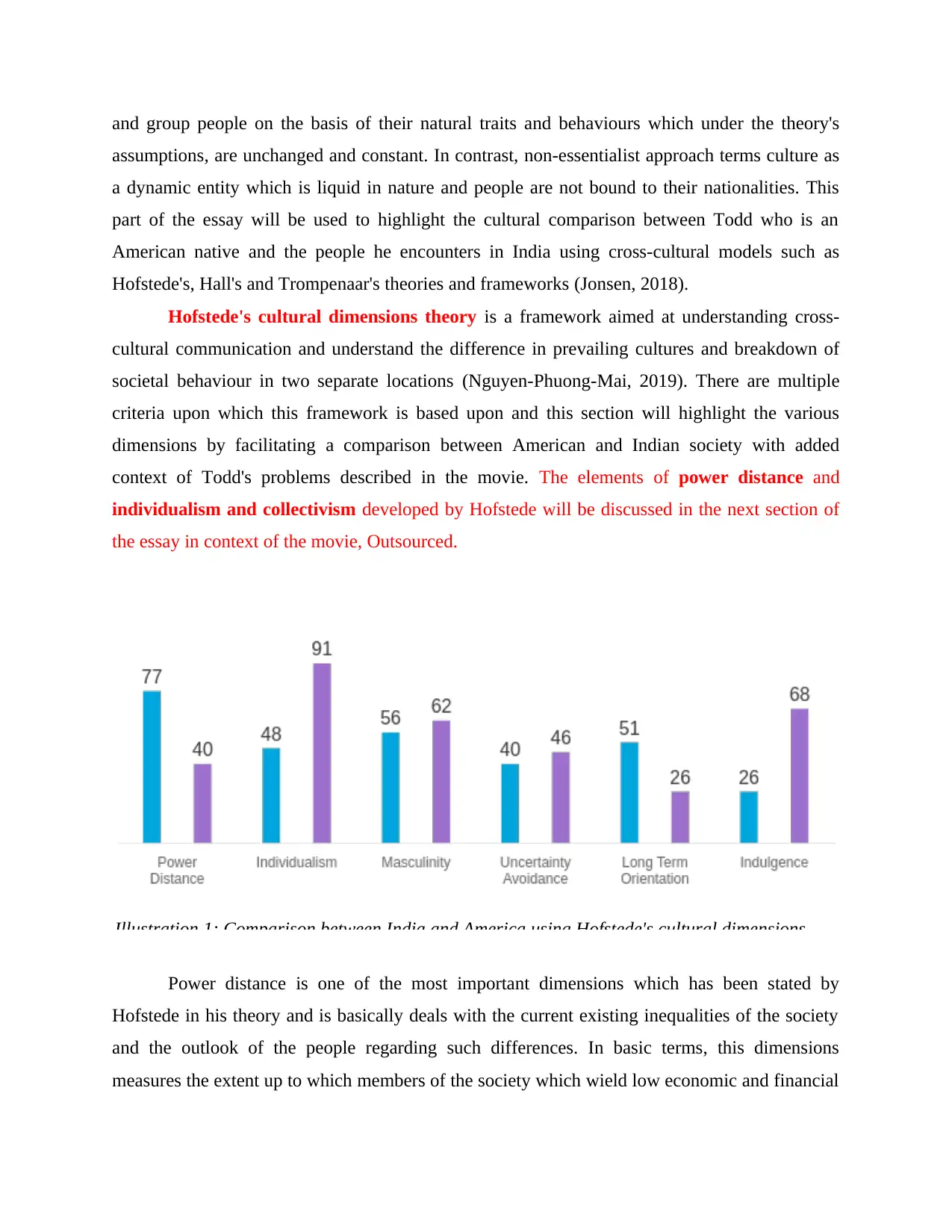
and group people on the basis of their natural traits and behaviours which under the theory's
assumptions, are unchanged and constant. In contrast, non-essentialist approach terms culture as
a dynamic entity which is liquid in nature and people are not bound to their nationalities. This
part of the essay will be used to highlight the cultural comparison between Todd who is an
American native and the people he encounters in India using cross-cultural models such as
Hofstede's, Hall's and Trompenaar's theories and frameworks (Jonsen, 2018).
Hofstede's cultural dimensions theory is a framework aimed at understanding cross-
cultural communication and understand the difference in prevailing cultures and breakdown of
societal behaviour in two separate locations (Nguyen-Phuong-Mai, 2019). There are multiple
criteria upon which this framework is based upon and this section will highlight the various
dimensions by facilitating a comparison between American and Indian society with added
context of Todd's problems described in the movie. The elements of power distance and
individualism and collectivism developed by Hofstede will be discussed in the next section of
the essay in context of the movie, Outsourced.
Power distance is one of the most important dimensions which has been stated by
Hofstede in his theory and is basically deals with the current existing inequalities of the society
and the outlook of the people regarding such differences. In basic terms, this dimensions
measures the extent up to which members of the society which wield low economic and financial
Illustration 1: Comparison between India and America using Hofstede's cultural dimensions
assumptions, are unchanged and constant. In contrast, non-essentialist approach terms culture as
a dynamic entity which is liquid in nature and people are not bound to their nationalities. This
part of the essay will be used to highlight the cultural comparison between Todd who is an
American native and the people he encounters in India using cross-cultural models such as
Hofstede's, Hall's and Trompenaar's theories and frameworks (Jonsen, 2018).
Hofstede's cultural dimensions theory is a framework aimed at understanding cross-
cultural communication and understand the difference in prevailing cultures and breakdown of
societal behaviour in two separate locations (Nguyen-Phuong-Mai, 2019). There are multiple
criteria upon which this framework is based upon and this section will highlight the various
dimensions by facilitating a comparison between American and Indian society with added
context of Todd's problems described in the movie. The elements of power distance and
individualism and collectivism developed by Hofstede will be discussed in the next section of
the essay in context of the movie, Outsourced.
Power distance is one of the most important dimensions which has been stated by
Hofstede in his theory and is basically deals with the current existing inequalities of the society
and the outlook of the people regarding such differences. In basic terms, this dimensions
measures the extent up to which members of the society which wield low economic and financial
Illustration 1: Comparison between India and America using Hofstede's cultural dimensions
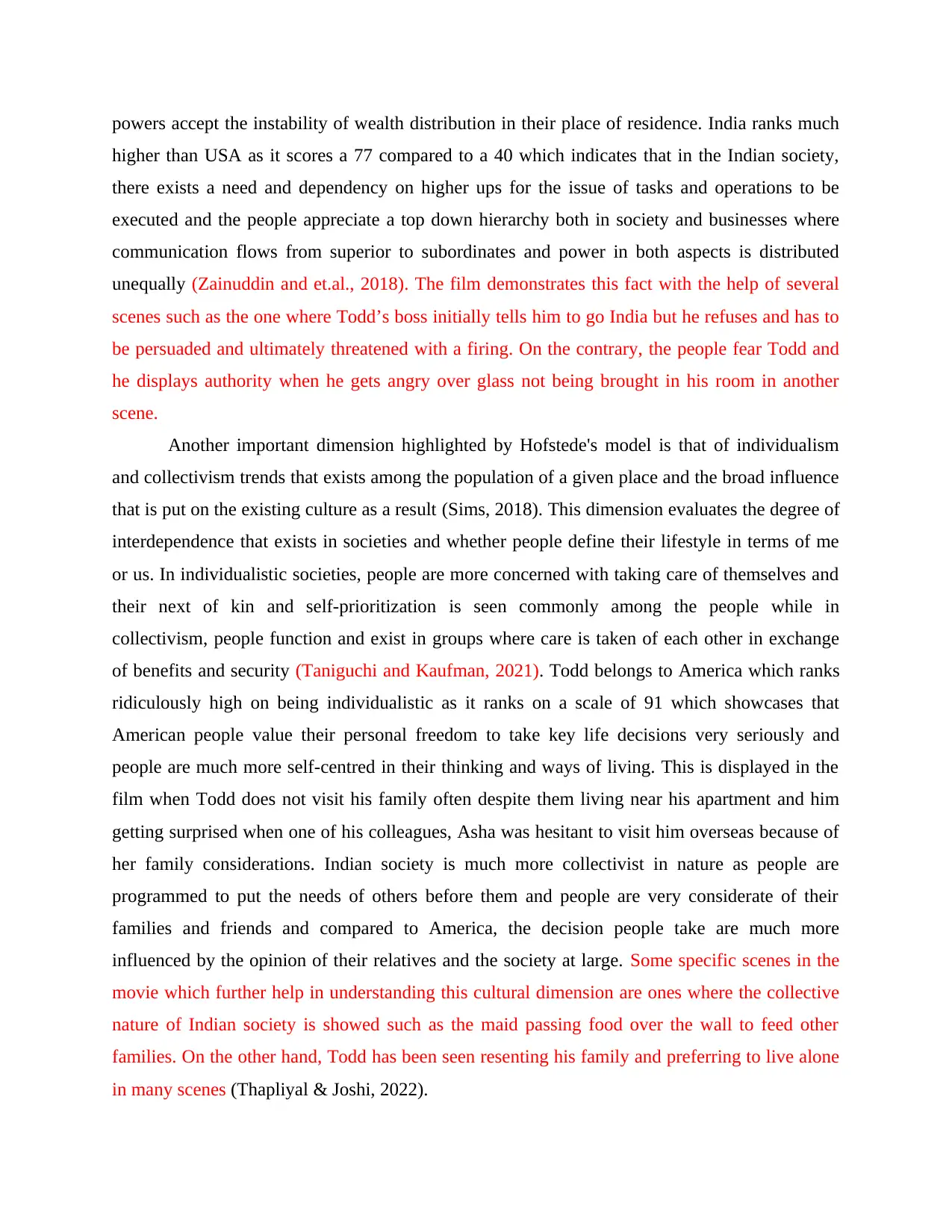
powers accept the instability of wealth distribution in their place of residence. India ranks much
higher than USA as it scores a 77 compared to a 40 which indicates that in the Indian society,
there exists a need and dependency on higher ups for the issue of tasks and operations to be
executed and the people appreciate a top down hierarchy both in society and businesses where
communication flows from superior to subordinates and power in both aspects is distributed
unequally (Zainuddin and et.al., 2018). The film demonstrates this fact with the help of several
scenes such as the one where Todd’s boss initially tells him to go India but he refuses and has to
be persuaded and ultimately threatened with a firing. On the contrary, the people fear Todd and
he displays authority when he gets angry over glass not being brought in his room in another
scene.
Another important dimension highlighted by Hofstede's model is that of individualism
and collectivism trends that exists among the population of a given place and the broad influence
that is put on the existing culture as a result (Sims, 2018). This dimension evaluates the degree of
interdependence that exists in societies and whether people define their lifestyle in terms of me
or us. In individualistic societies, people are more concerned with taking care of themselves and
their next of kin and self-prioritization is seen commonly among the people while in
collectivism, people function and exist in groups where care is taken of each other in exchange
of benefits and security (Taniguchi and Kaufman, 2021). Todd belongs to America which ranks
ridiculously high on being individualistic as it ranks on a scale of 91 which showcases that
American people value their personal freedom to take key life decisions very seriously and
people are much more self-centred in their thinking and ways of living. This is displayed in the
film when Todd does not visit his family often despite them living near his apartment and him
getting surprised when one of his colleagues, Asha was hesitant to visit him overseas because of
her family considerations. Indian society is much more collectivist in nature as people are
programmed to put the needs of others before them and people are very considerate of their
families and friends and compared to America, the decision people take are much more
influenced by the opinion of their relatives and the society at large. Some specific scenes in the
movie which further help in understanding this cultural dimension are ones where the collective
nature of Indian society is showed such as the maid passing food over the wall to feed other
families. On the other hand, Todd has been seen resenting his family and preferring to live alone
in many scenes (Thapliyal & Joshi, 2022).
higher than USA as it scores a 77 compared to a 40 which indicates that in the Indian society,
there exists a need and dependency on higher ups for the issue of tasks and operations to be
executed and the people appreciate a top down hierarchy both in society and businesses where
communication flows from superior to subordinates and power in both aspects is distributed
unequally (Zainuddin and et.al., 2018). The film demonstrates this fact with the help of several
scenes such as the one where Todd’s boss initially tells him to go India but he refuses and has to
be persuaded and ultimately threatened with a firing. On the contrary, the people fear Todd and
he displays authority when he gets angry over glass not being brought in his room in another
scene.
Another important dimension highlighted by Hofstede's model is that of individualism
and collectivism trends that exists among the population of a given place and the broad influence
that is put on the existing culture as a result (Sims, 2018). This dimension evaluates the degree of
interdependence that exists in societies and whether people define their lifestyle in terms of me
or us. In individualistic societies, people are more concerned with taking care of themselves and
their next of kin and self-prioritization is seen commonly among the people while in
collectivism, people function and exist in groups where care is taken of each other in exchange
of benefits and security (Taniguchi and Kaufman, 2021). Todd belongs to America which ranks
ridiculously high on being individualistic as it ranks on a scale of 91 which showcases that
American people value their personal freedom to take key life decisions very seriously and
people are much more self-centred in their thinking and ways of living. This is displayed in the
film when Todd does not visit his family often despite them living near his apartment and him
getting surprised when one of his colleagues, Asha was hesitant to visit him overseas because of
her family considerations. Indian society is much more collectivist in nature as people are
programmed to put the needs of others before them and people are very considerate of their
families and friends and compared to America, the decision people take are much more
influenced by the opinion of their relatives and the society at large. Some specific scenes in the
movie which further help in understanding this cultural dimension are ones where the collective
nature of Indian society is showed such as the maid passing food over the wall to feed other
families. On the other hand, Todd has been seen resenting his family and preferring to live alone
in many scenes (Thapliyal & Joshi, 2022).
⊘ This is a preview!⊘
Do you want full access?
Subscribe today to unlock all pages.

Trusted by 1+ million students worldwide
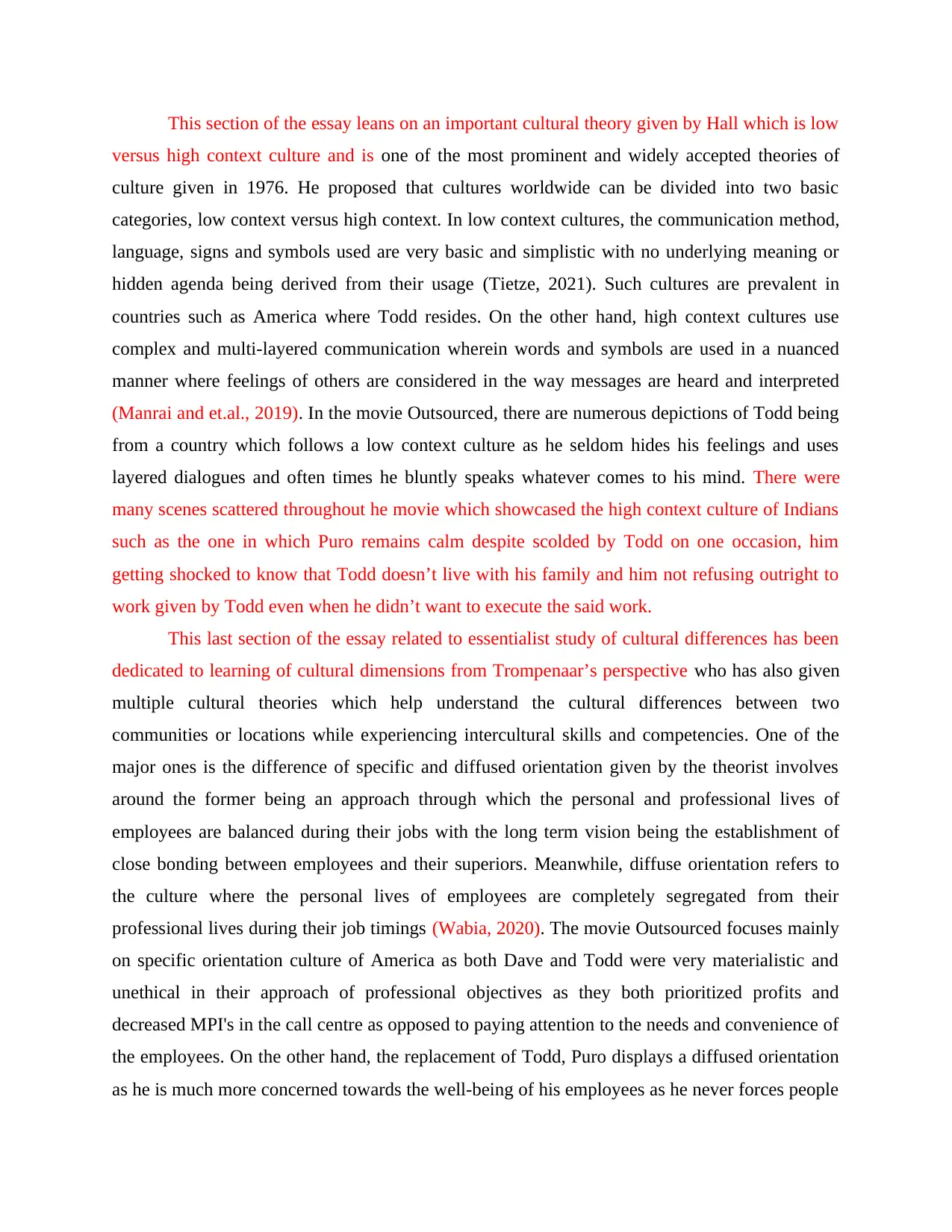
This section of the essay leans on an important cultural theory given by Hall which is low
versus high context culture and is one of the most prominent and widely accepted theories of
culture given in 1976. He proposed that cultures worldwide can be divided into two basic
categories, low context versus high context. In low context cultures, the communication method,
language, signs and symbols used are very basic and simplistic with no underlying meaning or
hidden agenda being derived from their usage (Tietze, 2021). Such cultures are prevalent in
countries such as America where Todd resides. On the other hand, high context cultures use
complex and multi-layered communication wherein words and symbols are used in a nuanced
manner where feelings of others are considered in the way messages are heard and interpreted
(Manrai and et.al., 2019). In the movie Outsourced, there are numerous depictions of Todd being
from a country which follows a low context culture as he seldom hides his feelings and uses
layered dialogues and often times he bluntly speaks whatever comes to his mind. There were
many scenes scattered throughout he movie which showcased the high context culture of Indians
such as the one in which Puro remains calm despite scolded by Todd on one occasion, him
getting shocked to know that Todd doesn’t live with his family and him not refusing outright to
work given by Todd even when he didn’t want to execute the said work.
This last section of the essay related to essentialist study of cultural differences has been
dedicated to learning of cultural dimensions from Trompenaar’s perspective who has also given
multiple cultural theories which help understand the cultural differences between two
communities or locations while experiencing intercultural skills and competencies. One of the
major ones is the difference of specific and diffused orientation given by the theorist involves
around the former being an approach through which the personal and professional lives of
employees are balanced during their jobs with the long term vision being the establishment of
close bonding between employees and their superiors. Meanwhile, diffuse orientation refers to
the culture where the personal lives of employees are completely segregated from their
professional lives during their job timings (Wabia, 2020). The movie Outsourced focuses mainly
on specific orientation culture of America as both Dave and Todd were very materialistic and
unethical in their approach of professional objectives as they both prioritized profits and
decreased MPI's in the call centre as opposed to paying attention to the needs and convenience of
the employees. On the other hand, the replacement of Todd, Puro displays a diffused orientation
as he is much more concerned towards the well-being of his employees as he never forces people
versus high context culture and is one of the most prominent and widely accepted theories of
culture given in 1976. He proposed that cultures worldwide can be divided into two basic
categories, low context versus high context. In low context cultures, the communication method,
language, signs and symbols used are very basic and simplistic with no underlying meaning or
hidden agenda being derived from their usage (Tietze, 2021). Such cultures are prevalent in
countries such as America where Todd resides. On the other hand, high context cultures use
complex and multi-layered communication wherein words and symbols are used in a nuanced
manner where feelings of others are considered in the way messages are heard and interpreted
(Manrai and et.al., 2019). In the movie Outsourced, there are numerous depictions of Todd being
from a country which follows a low context culture as he seldom hides his feelings and uses
layered dialogues and often times he bluntly speaks whatever comes to his mind. There were
many scenes scattered throughout he movie which showcased the high context culture of Indians
such as the one in which Puro remains calm despite scolded by Todd on one occasion, him
getting shocked to know that Todd doesn’t live with his family and him not refusing outright to
work given by Todd even when he didn’t want to execute the said work.
This last section of the essay related to essentialist study of cultural differences has been
dedicated to learning of cultural dimensions from Trompenaar’s perspective who has also given
multiple cultural theories which help understand the cultural differences between two
communities or locations while experiencing intercultural skills and competencies. One of the
major ones is the difference of specific and diffused orientation given by the theorist involves
around the former being an approach through which the personal and professional lives of
employees are balanced during their jobs with the long term vision being the establishment of
close bonding between employees and their superiors. Meanwhile, diffuse orientation refers to
the culture where the personal lives of employees are completely segregated from their
professional lives during their job timings (Wabia, 2020). The movie Outsourced focuses mainly
on specific orientation culture of America as both Dave and Todd were very materialistic and
unethical in their approach of professional objectives as they both prioritized profits and
decreased MPI's in the call centre as opposed to paying attention to the needs and convenience of
the employees. On the other hand, the replacement of Todd, Puro displays a diffused orientation
as he is much more concerned towards the well-being of his employees as he never forces people
Paraphrase This Document
Need a fresh take? Get an instant paraphrase of this document with our AI Paraphraser
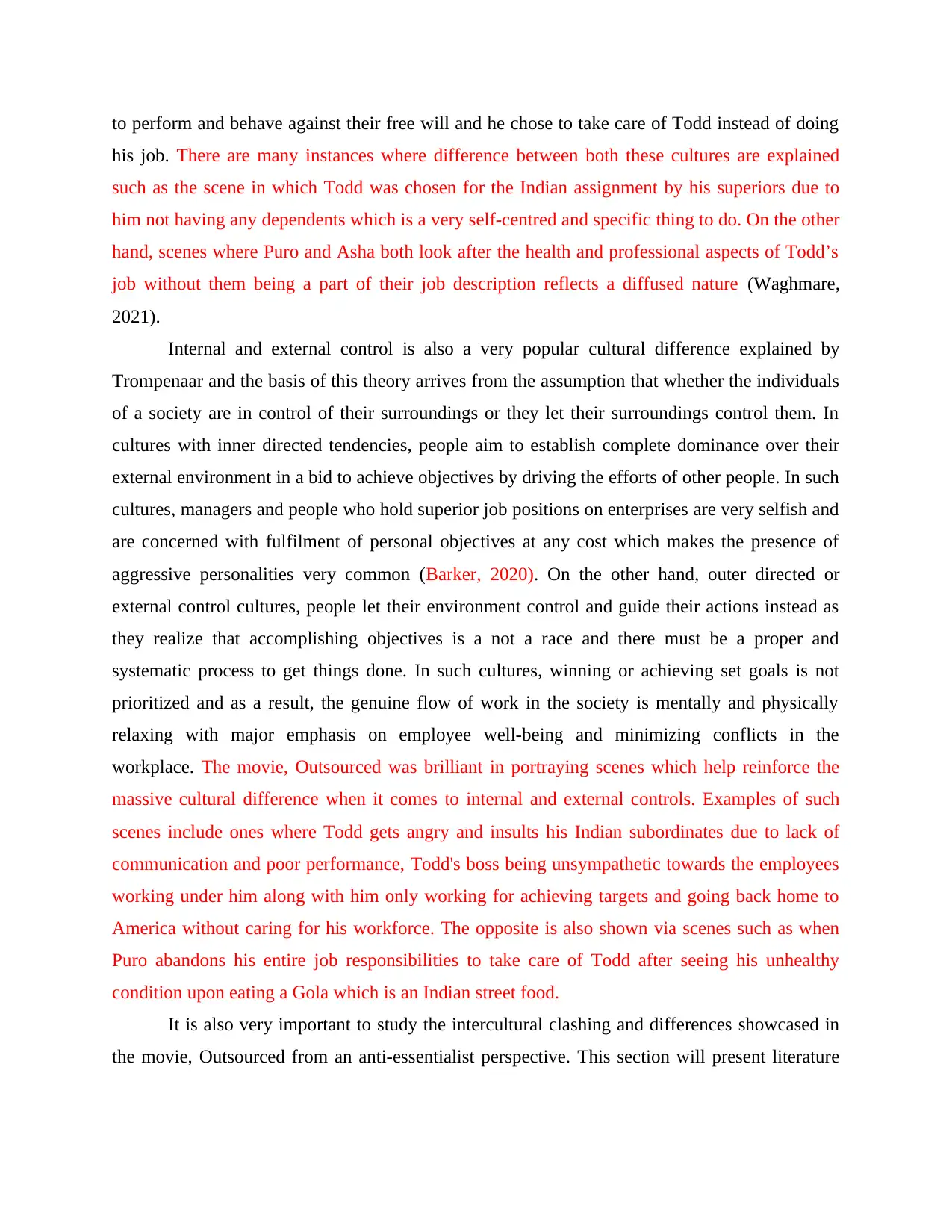
to perform and behave against their free will and he chose to take care of Todd instead of doing
his job. There are many instances where difference between both these cultures are explained
such as the scene in which Todd was chosen for the Indian assignment by his superiors due to
him not having any dependents which is a very self-centred and specific thing to do. On the other
hand, scenes where Puro and Asha both look after the health and professional aspects of Todd’s
job without them being a part of their job description reflects a diffused nature (Waghmare,
2021).
Internal and external control is also a very popular cultural difference explained by
Trompenaar and the basis of this theory arrives from the assumption that whether the individuals
of a society are in control of their surroundings or they let their surroundings control them. In
cultures with inner directed tendencies, people aim to establish complete dominance over their
external environment in a bid to achieve objectives by driving the efforts of other people. In such
cultures, managers and people who hold superior job positions on enterprises are very selfish and
are concerned with fulfilment of personal objectives at any cost which makes the presence of
aggressive personalities very common (Barker, 2020). On the other hand, outer directed or
external control cultures, people let their environment control and guide their actions instead as
they realize that accomplishing objectives is a not a race and there must be a proper and
systematic process to get things done. In such cultures, winning or achieving set goals is not
prioritized and as a result, the genuine flow of work in the society is mentally and physically
relaxing with major emphasis on employee well-being and minimizing conflicts in the
workplace. The movie, Outsourced was brilliant in portraying scenes which help reinforce the
massive cultural difference when it comes to internal and external controls. Examples of such
scenes include ones where Todd gets angry and insults his Indian subordinates due to lack of
communication and poor performance, Todd's boss being unsympathetic towards the employees
working under him along with him only working for achieving targets and going back home to
America without caring for his workforce. The opposite is also shown via scenes such as when
Puro abandons his entire job responsibilities to take care of Todd after seeing his unhealthy
condition upon eating a Gola which is an Indian street food.
It is also very important to study the intercultural clashing and differences showcased in
the movie, Outsourced from an anti-essentialist perspective. This section will present literature
his job. There are many instances where difference between both these cultures are explained
such as the scene in which Todd was chosen for the Indian assignment by his superiors due to
him not having any dependents which is a very self-centred and specific thing to do. On the other
hand, scenes where Puro and Asha both look after the health and professional aspects of Todd’s
job without them being a part of their job description reflects a diffused nature (Waghmare,
2021).
Internal and external control is also a very popular cultural difference explained by
Trompenaar and the basis of this theory arrives from the assumption that whether the individuals
of a society are in control of their surroundings or they let their surroundings control them. In
cultures with inner directed tendencies, people aim to establish complete dominance over their
external environment in a bid to achieve objectives by driving the efforts of other people. In such
cultures, managers and people who hold superior job positions on enterprises are very selfish and
are concerned with fulfilment of personal objectives at any cost which makes the presence of
aggressive personalities very common (Barker, 2020). On the other hand, outer directed or
external control cultures, people let their environment control and guide their actions instead as
they realize that accomplishing objectives is a not a race and there must be a proper and
systematic process to get things done. In such cultures, winning or achieving set goals is not
prioritized and as a result, the genuine flow of work in the society is mentally and physically
relaxing with major emphasis on employee well-being and minimizing conflicts in the
workplace. The movie, Outsourced was brilliant in portraying scenes which help reinforce the
massive cultural difference when it comes to internal and external controls. Examples of such
scenes include ones where Todd gets angry and insults his Indian subordinates due to lack of
communication and poor performance, Todd's boss being unsympathetic towards the employees
working under him along with him only working for achieving targets and going back home to
America without caring for his workforce. The opposite is also shown via scenes such as when
Puro abandons his entire job responsibilities to take care of Todd after seeing his unhealthy
condition upon eating a Gola which is an Indian street food.
It is also very important to study the intercultural clashing and differences showcased in
the movie, Outsourced from an anti-essentialist perspective. This section will present literature
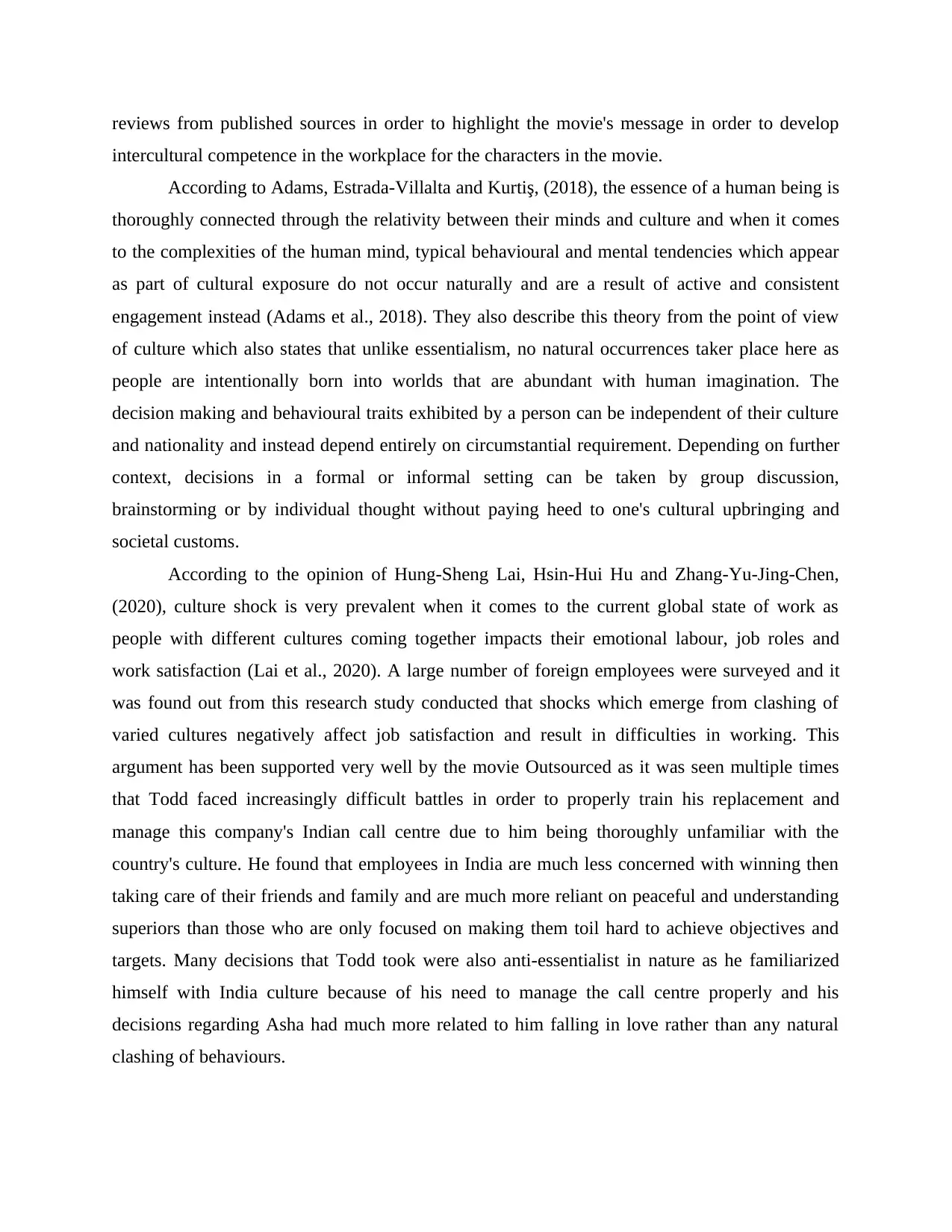
reviews from published sources in order to highlight the movie's message in order to develop
intercultural competence in the workplace for the characters in the movie.
According to Adams, Estrada-Villalta and Kurtiş, (2018), the essence of a human being is
thoroughly connected through the relativity between their minds and culture and when it comes
to the complexities of the human mind, typical behavioural and mental tendencies which appear
as part of cultural exposure do not occur naturally and are a result of active and consistent
engagement instead (Adams et al., 2018). They also describe this theory from the point of view
of culture which also states that unlike essentialism, no natural occurrences taker place here as
people are intentionally born into worlds that are abundant with human imagination. The
decision making and behavioural traits exhibited by a person can be independent of their culture
and nationality and instead depend entirely on circumstantial requirement. Depending on further
context, decisions in a formal or informal setting can be taken by group discussion,
brainstorming or by individual thought without paying heed to one's cultural upbringing and
societal customs.
According to the opinion of Hung-Sheng Lai, Hsin-Hui Hu and Zhang-Yu-Jing-Chen,
(2020), culture shock is very prevalent when it comes to the current global state of work as
people with different cultures coming together impacts their emotional labour, job roles and
work satisfaction (Lai et al., 2020). A large number of foreign employees were surveyed and it
was found out from this research study conducted that shocks which emerge from clashing of
varied cultures negatively affect job satisfaction and result in difficulties in working. This
argument has been supported very well by the movie Outsourced as it was seen multiple times
that Todd faced increasingly difficult battles in order to properly train his replacement and
manage this company's Indian call centre due to him being thoroughly unfamiliar with the
country's culture. He found that employees in India are much less concerned with winning then
taking care of their friends and family and are much more reliant on peaceful and understanding
superiors than those who are only focused on making them toil hard to achieve objectives and
targets. Many decisions that Todd took were also anti-essentialist in nature as he familiarized
himself with India culture because of his need to manage the call centre properly and his
decisions regarding Asha had much more related to him falling in love rather than any natural
clashing of behaviours.
intercultural competence in the workplace for the characters in the movie.
According to Adams, Estrada-Villalta and Kurtiş, (2018), the essence of a human being is
thoroughly connected through the relativity between their minds and culture and when it comes
to the complexities of the human mind, typical behavioural and mental tendencies which appear
as part of cultural exposure do not occur naturally and are a result of active and consistent
engagement instead (Adams et al., 2018). They also describe this theory from the point of view
of culture which also states that unlike essentialism, no natural occurrences taker place here as
people are intentionally born into worlds that are abundant with human imagination. The
decision making and behavioural traits exhibited by a person can be independent of their culture
and nationality and instead depend entirely on circumstantial requirement. Depending on further
context, decisions in a formal or informal setting can be taken by group discussion,
brainstorming or by individual thought without paying heed to one's cultural upbringing and
societal customs.
According to the opinion of Hung-Sheng Lai, Hsin-Hui Hu and Zhang-Yu-Jing-Chen,
(2020), culture shock is very prevalent when it comes to the current global state of work as
people with different cultures coming together impacts their emotional labour, job roles and
work satisfaction (Lai et al., 2020). A large number of foreign employees were surveyed and it
was found out from this research study conducted that shocks which emerge from clashing of
varied cultures negatively affect job satisfaction and result in difficulties in working. This
argument has been supported very well by the movie Outsourced as it was seen multiple times
that Todd faced increasingly difficult battles in order to properly train his replacement and
manage this company's Indian call centre due to him being thoroughly unfamiliar with the
country's culture. He found that employees in India are much less concerned with winning then
taking care of their friends and family and are much more reliant on peaceful and understanding
superiors than those who are only focused on making them toil hard to achieve objectives and
targets. Many decisions that Todd took were also anti-essentialist in nature as he familiarized
himself with India culture because of his need to manage the call centre properly and his
decisions regarding Asha had much more related to him falling in love rather than any natural
clashing of behaviours.
⊘ This is a preview!⊘
Do you want full access?
Subscribe today to unlock all pages.

Trusted by 1+ million students worldwide
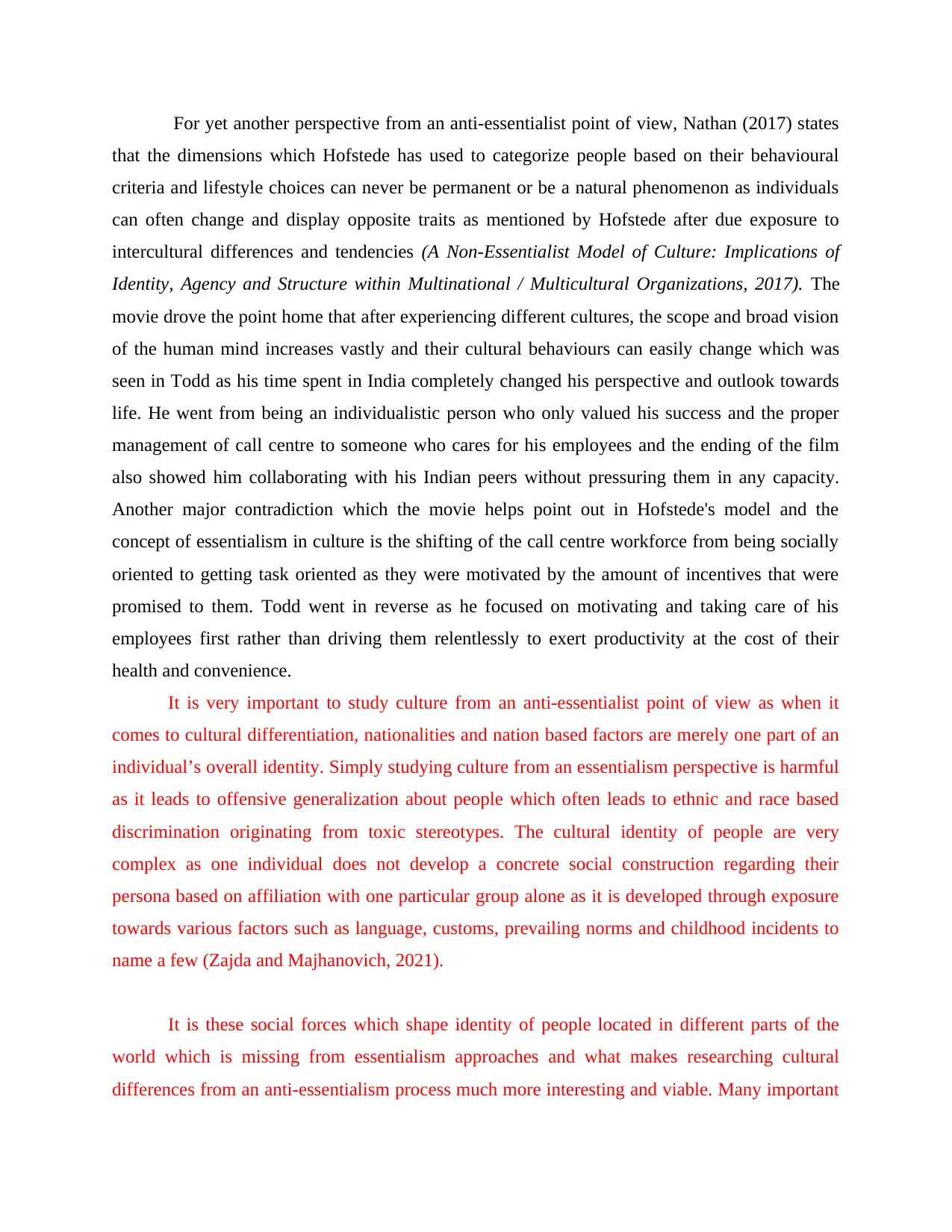
For yet another perspective from an anti-essentialist point of view, Nathan (2017) states
that the dimensions which Hofstede has used to categorize people based on their behavioural
criteria and lifestyle choices can never be permanent or be a natural phenomenon as individuals
can often change and display opposite traits as mentioned by Hofstede after due exposure to
intercultural differences and tendencies (A Non-Essentialist Model of Culture: Implications of
Identity, Agency and Structure within Multinational / Multicultural Organizations, 2017). The
movie drove the point home that after experiencing different cultures, the scope and broad vision
of the human mind increases vastly and their cultural behaviours can easily change which was
seen in Todd as his time spent in India completely changed his perspective and outlook towards
life. He went from being an individualistic person who only valued his success and the proper
management of call centre to someone who cares for his employees and the ending of the film
also showed him collaborating with his Indian peers without pressuring them in any capacity.
Another major contradiction which the movie helps point out in Hofstede's model and the
concept of essentialism in culture is the shifting of the call centre workforce from being socially
oriented to getting task oriented as they were motivated by the amount of incentives that were
promised to them. Todd went in reverse as he focused on motivating and taking care of his
employees first rather than driving them relentlessly to exert productivity at the cost of their
health and convenience.
It is very important to study culture from an anti-essentialist point of view as when it
comes to cultural differentiation, nationalities and nation based factors are merely one part of an
individual’s overall identity. Simply studying culture from an essentialism perspective is harmful
as it leads to offensive generalization about people which often leads to ethnic and race based
discrimination originating from toxic stereotypes. The cultural identity of people are very
complex as one individual does not develop a concrete social construction regarding their
persona based on affiliation with one particular group alone as it is developed through exposure
towards various factors such as language, customs, prevailing norms and childhood incidents to
name a few (Zajda and Majhanovich, 2021).
It is these social forces which shape identity of people located in different parts of the
world which is missing from essentialism approaches and what makes researching cultural
differences from an anti-essentialism process much more interesting and viable. Many important
that the dimensions which Hofstede has used to categorize people based on their behavioural
criteria and lifestyle choices can never be permanent or be a natural phenomenon as individuals
can often change and display opposite traits as mentioned by Hofstede after due exposure to
intercultural differences and tendencies (A Non-Essentialist Model of Culture: Implications of
Identity, Agency and Structure within Multinational / Multicultural Organizations, 2017). The
movie drove the point home that after experiencing different cultures, the scope and broad vision
of the human mind increases vastly and their cultural behaviours can easily change which was
seen in Todd as his time spent in India completely changed his perspective and outlook towards
life. He went from being an individualistic person who only valued his success and the proper
management of call centre to someone who cares for his employees and the ending of the film
also showed him collaborating with his Indian peers without pressuring them in any capacity.
Another major contradiction which the movie helps point out in Hofstede's model and the
concept of essentialism in culture is the shifting of the call centre workforce from being socially
oriented to getting task oriented as they were motivated by the amount of incentives that were
promised to them. Todd went in reverse as he focused on motivating and taking care of his
employees first rather than driving them relentlessly to exert productivity at the cost of their
health and convenience.
It is very important to study culture from an anti-essentialist point of view as when it
comes to cultural differentiation, nationalities and nation based factors are merely one part of an
individual’s overall identity. Simply studying culture from an essentialism perspective is harmful
as it leads to offensive generalization about people which often leads to ethnic and race based
discrimination originating from toxic stereotypes. The cultural identity of people are very
complex as one individual does not develop a concrete social construction regarding their
persona based on affiliation with one particular group alone as it is developed through exposure
towards various factors such as language, customs, prevailing norms and childhood incidents to
name a few (Zajda and Majhanovich, 2021).
It is these social forces which shape identity of people located in different parts of the
world which is missing from essentialism approaches and what makes researching cultural
differences from an anti-essentialism process much more interesting and viable. Many important
Paraphrase This Document
Need a fresh take? Get an instant paraphrase of this document with our AI Paraphraser
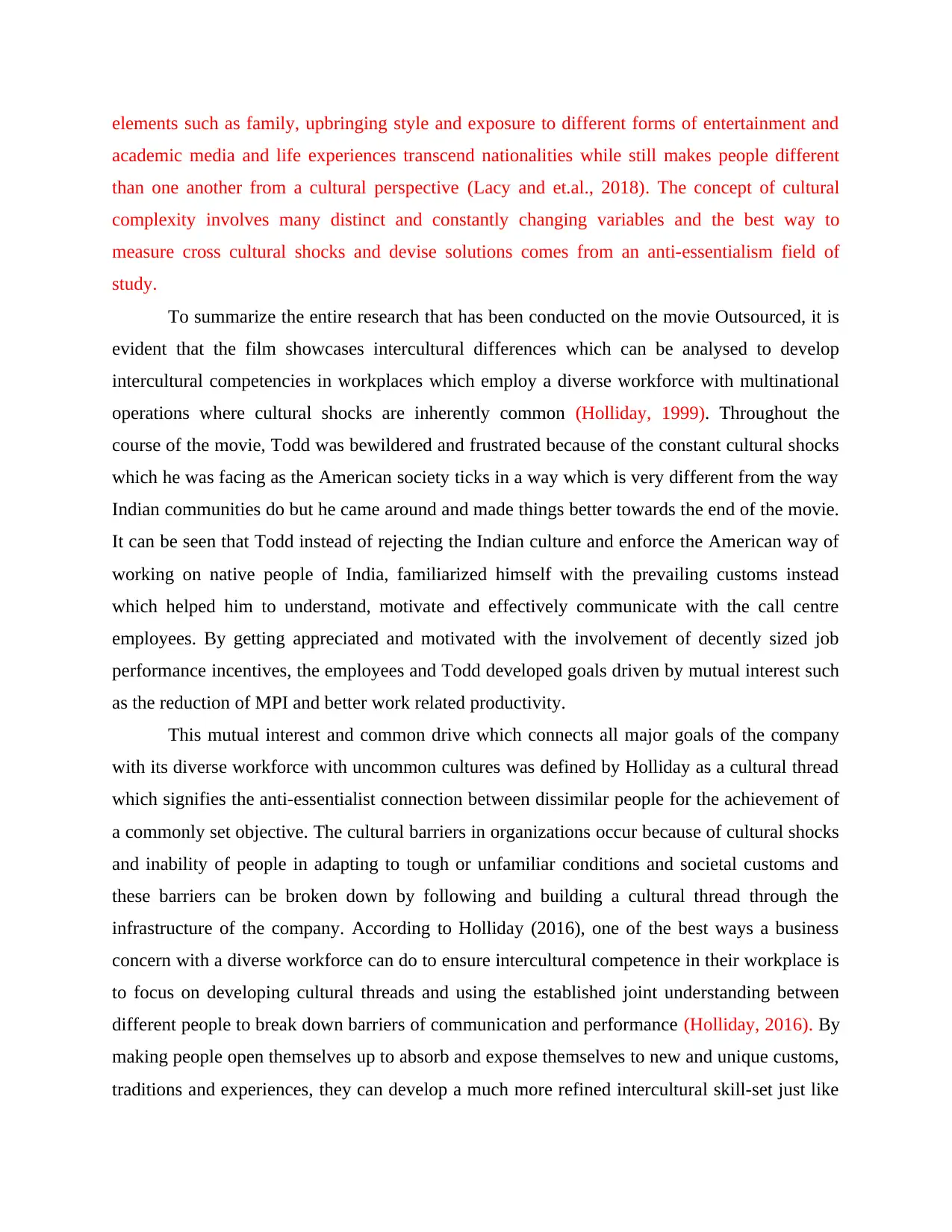
elements such as family, upbringing style and exposure to different forms of entertainment and
academic media and life experiences transcend nationalities while still makes people different
than one another from a cultural perspective (Lacy and et.al., 2018). The concept of cultural
complexity involves many distinct and constantly changing variables and the best way to
measure cross cultural shocks and devise solutions comes from an anti-essentialism field of
study.
To summarize the entire research that has been conducted on the movie Outsourced, it is
evident that the film showcases intercultural differences which can be analysed to develop
intercultural competencies in workplaces which employ a diverse workforce with multinational
operations where cultural shocks are inherently common (Holliday, 1999). Throughout the
course of the movie, Todd was bewildered and frustrated because of the constant cultural shocks
which he was facing as the American society ticks in a way which is very different from the way
Indian communities do but he came around and made things better towards the end of the movie.
It can be seen that Todd instead of rejecting the Indian culture and enforce the American way of
working on native people of India, familiarized himself with the prevailing customs instead
which helped him to understand, motivate and effectively communicate with the call centre
employees. By getting appreciated and motivated with the involvement of decently sized job
performance incentives, the employees and Todd developed goals driven by mutual interest such
as the reduction of MPI and better work related productivity.
This mutual interest and common drive which connects all major goals of the company
with its diverse workforce with uncommon cultures was defined by Holliday as a cultural thread
which signifies the anti-essentialist connection between dissimilar people for the achievement of
a commonly set objective. The cultural barriers in organizations occur because of cultural shocks
and inability of people in adapting to tough or unfamiliar conditions and societal customs and
these barriers can be broken down by following and building a cultural thread through the
infrastructure of the company. According to Holliday (2016), one of the best ways a business
concern with a diverse workforce can do to ensure intercultural competence in their workplace is
to focus on developing cultural threads and using the established joint understanding between
different people to break down barriers of communication and performance (Holliday, 2016). By
making people open themselves up to absorb and expose themselves to new and unique customs,
traditions and experiences, they can develop a much more refined intercultural skill-set just like
academic media and life experiences transcend nationalities while still makes people different
than one another from a cultural perspective (Lacy and et.al., 2018). The concept of cultural
complexity involves many distinct and constantly changing variables and the best way to
measure cross cultural shocks and devise solutions comes from an anti-essentialism field of
study.
To summarize the entire research that has been conducted on the movie Outsourced, it is
evident that the film showcases intercultural differences which can be analysed to develop
intercultural competencies in workplaces which employ a diverse workforce with multinational
operations where cultural shocks are inherently common (Holliday, 1999). Throughout the
course of the movie, Todd was bewildered and frustrated because of the constant cultural shocks
which he was facing as the American society ticks in a way which is very different from the way
Indian communities do but he came around and made things better towards the end of the movie.
It can be seen that Todd instead of rejecting the Indian culture and enforce the American way of
working on native people of India, familiarized himself with the prevailing customs instead
which helped him to understand, motivate and effectively communicate with the call centre
employees. By getting appreciated and motivated with the involvement of decently sized job
performance incentives, the employees and Todd developed goals driven by mutual interest such
as the reduction of MPI and better work related productivity.
This mutual interest and common drive which connects all major goals of the company
with its diverse workforce with uncommon cultures was defined by Holliday as a cultural thread
which signifies the anti-essentialist connection between dissimilar people for the achievement of
a commonly set objective. The cultural barriers in organizations occur because of cultural shocks
and inability of people in adapting to tough or unfamiliar conditions and societal customs and
these barriers can be broken down by following and building a cultural thread through the
infrastructure of the company. According to Holliday (2016), one of the best ways a business
concern with a diverse workforce can do to ensure intercultural competence in their workplace is
to focus on developing cultural threads and using the established joint understanding between
different people to break down barriers of communication and performance (Holliday, 2016). By
making people open themselves up to absorb and expose themselves to new and unique customs,
traditions and experiences, they can develop a much more refined intercultural skill-set just like
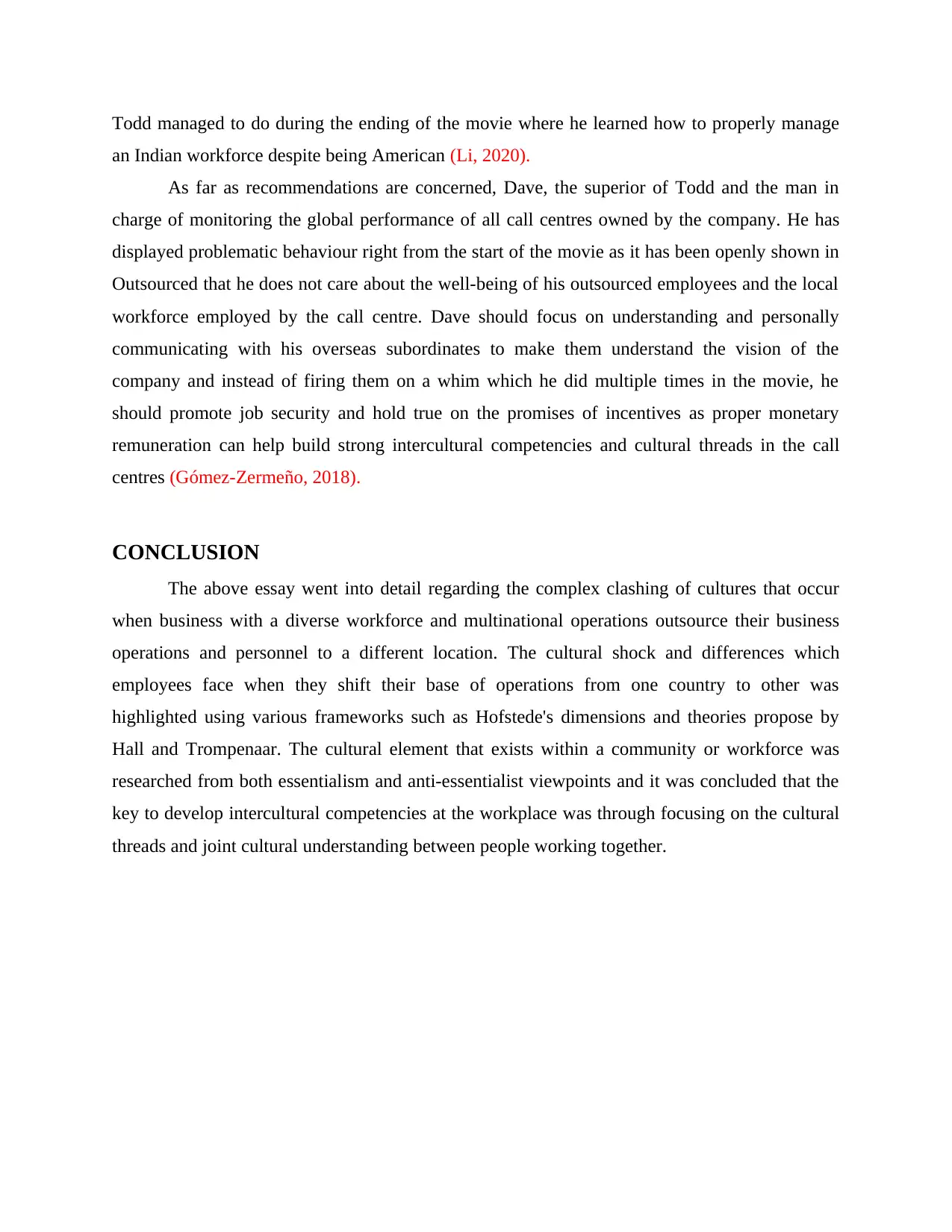
Todd managed to do during the ending of the movie where he learned how to properly manage
an Indian workforce despite being American (Li, 2020).
As far as recommendations are concerned, Dave, the superior of Todd and the man in
charge of monitoring the global performance of all call centres owned by the company. He has
displayed problematic behaviour right from the start of the movie as it has been openly shown in
Outsourced that he does not care about the well-being of his outsourced employees and the local
workforce employed by the call centre. Dave should focus on understanding and personally
communicating with his overseas subordinates to make them understand the vision of the
company and instead of firing them on a whim which he did multiple times in the movie, he
should promote job security and hold true on the promises of incentives as proper monetary
remuneration can help build strong intercultural competencies and cultural threads in the call
centres (Gómez-Zermeño, 2018).
CONCLUSION
The above essay went into detail regarding the complex clashing of cultures that occur
when business with a diverse workforce and multinational operations outsource their business
operations and personnel to a different location. The cultural shock and differences which
employees face when they shift their base of operations from one country to other was
highlighted using various frameworks such as Hofstede's dimensions and theories propose by
Hall and Trompenaar. The cultural element that exists within a community or workforce was
researched from both essentialism and anti-essentialist viewpoints and it was concluded that the
key to develop intercultural competencies at the workplace was through focusing on the cultural
threads and joint cultural understanding between people working together.
an Indian workforce despite being American (Li, 2020).
As far as recommendations are concerned, Dave, the superior of Todd and the man in
charge of monitoring the global performance of all call centres owned by the company. He has
displayed problematic behaviour right from the start of the movie as it has been openly shown in
Outsourced that he does not care about the well-being of his outsourced employees and the local
workforce employed by the call centre. Dave should focus on understanding and personally
communicating with his overseas subordinates to make them understand the vision of the
company and instead of firing them on a whim which he did multiple times in the movie, he
should promote job security and hold true on the promises of incentives as proper monetary
remuneration can help build strong intercultural competencies and cultural threads in the call
centres (Gómez-Zermeño, 2018).
CONCLUSION
The above essay went into detail regarding the complex clashing of cultures that occur
when business with a diverse workforce and multinational operations outsource their business
operations and personnel to a different location. The cultural shock and differences which
employees face when they shift their base of operations from one country to other was
highlighted using various frameworks such as Hofstede's dimensions and theories propose by
Hall and Trompenaar. The cultural element that exists within a community or workforce was
researched from both essentialism and anti-essentialist viewpoints and it was concluded that the
key to develop intercultural competencies at the workplace was through focusing on the cultural
threads and joint cultural understanding between people working together.
⊘ This is a preview!⊘
Do you want full access?
Subscribe today to unlock all pages.

Trusted by 1+ million students worldwide
1 out of 14
Related Documents
Your All-in-One AI-Powered Toolkit for Academic Success.
+13062052269
info@desklib.com
Available 24*7 on WhatsApp / Email
![[object Object]](/_next/static/media/star-bottom.7253800d.svg)
Unlock your academic potential
Copyright © 2020–2025 A2Z Services. All Rights Reserved. Developed and managed by ZUCOL.




